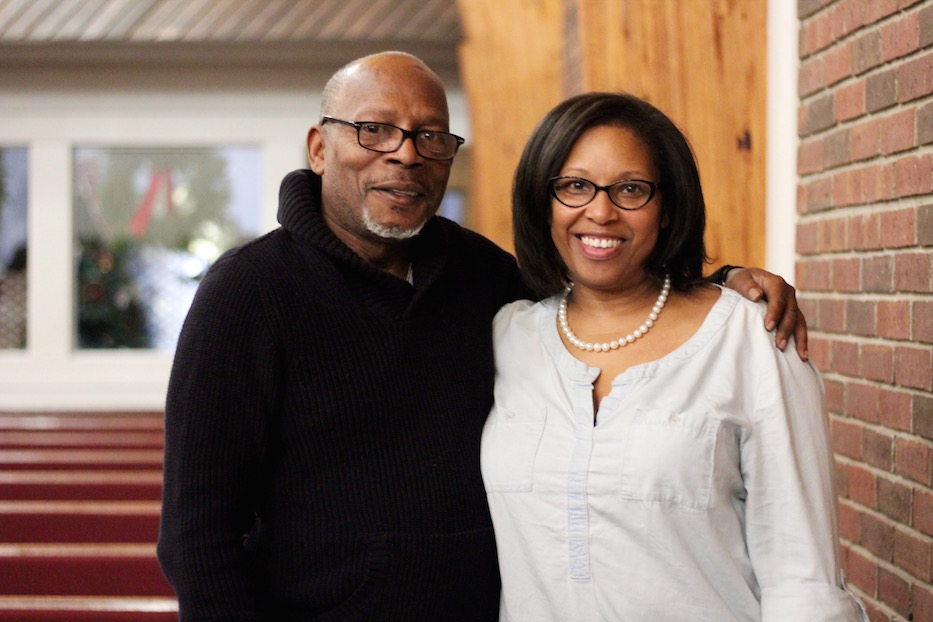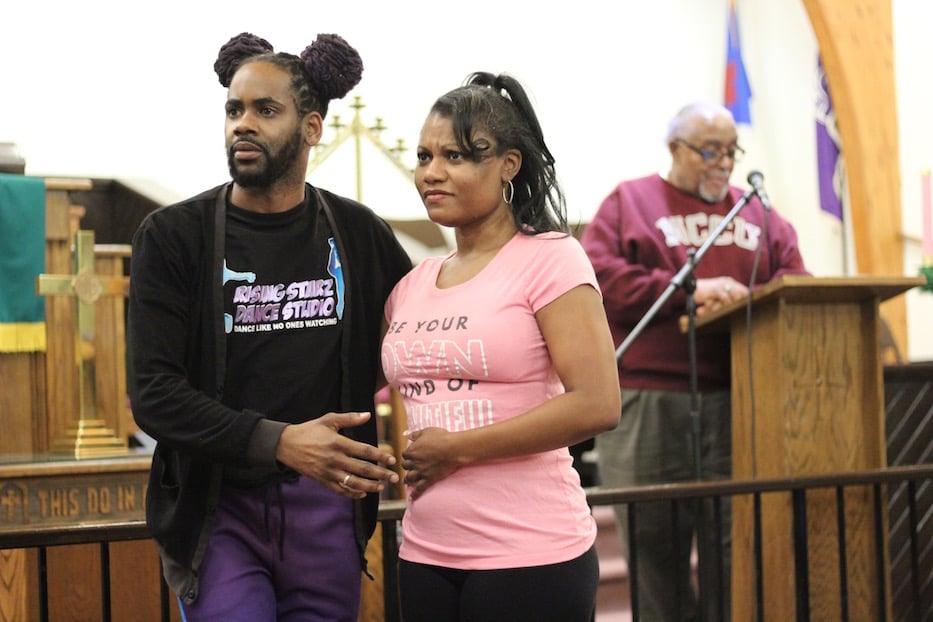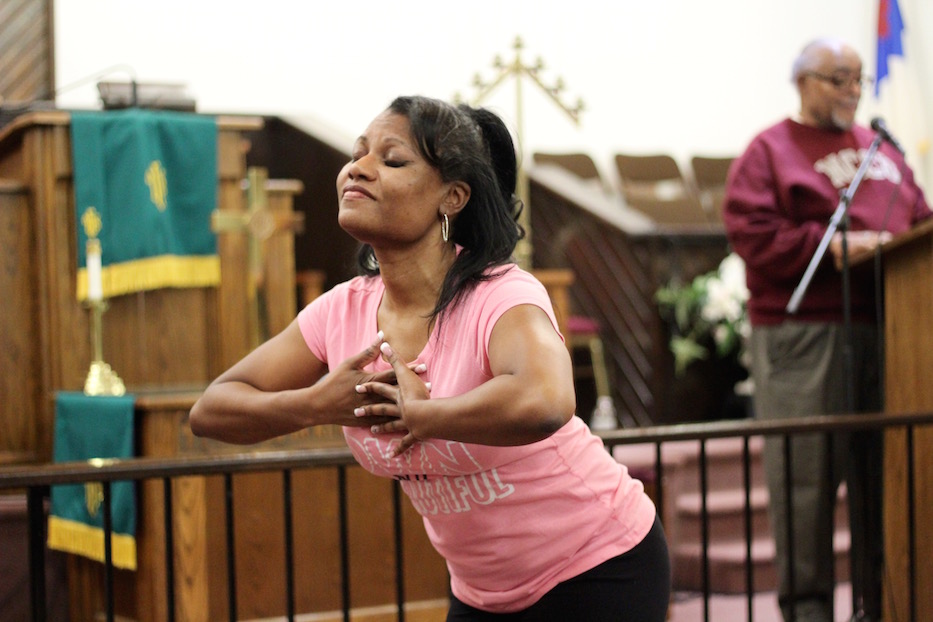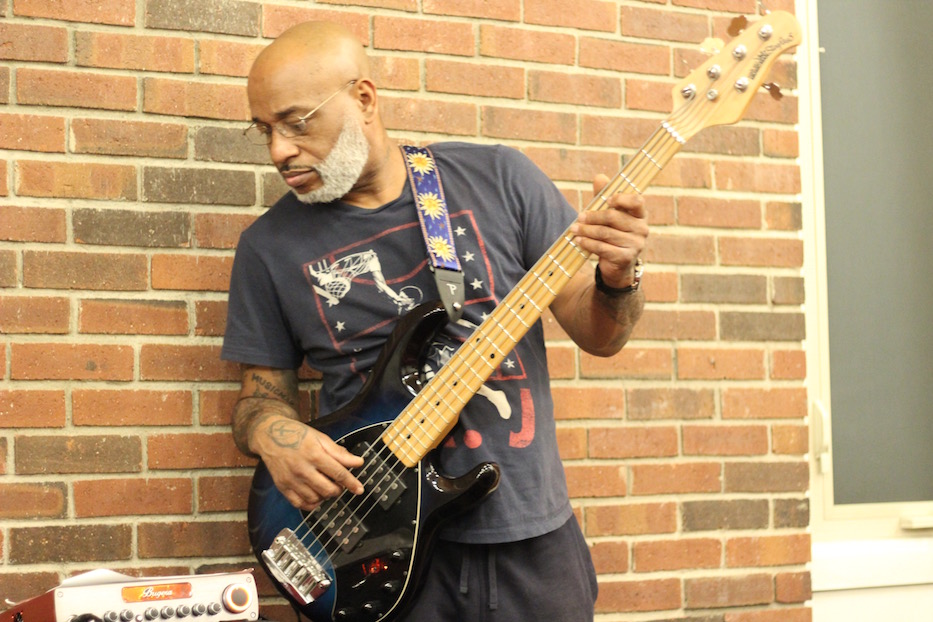
Arts & Culture | News From The Pews | Whalley/Edgewood/Beaver Hills

| Musical Director Elder Howard Taylor and Producer and Director Lisa Kellman at a recent rehearsal. Lucy Gellman Photos. |
Mary and Joseph are desperate for a place to rest their tired bodies. At the front of the church, they wander through a wilderness, hand in hand. Piano rises and swells around them. Voices roll out in a carpet of silk and satin. The lyrics confirm their fate: there is no room at the inn. They will have to keep pressing on.
Their bodies lurch forward, bringing to life one of the oldest stories ever told.
So unfolds a gorgeous, muscled adaptation of Langston Hughes’ Black Nativity at Bethel African Methodist Episcopal Church, opening this weekend at the church’s Goffe Street home. It is the second consecutive year that Bethel’s music department has put on the show, after a single packed performance and calls for an encore in December 2018.
Performers include original members of the now-disbanded Vernon Jones Singers, who first brought Black Nativity to New Haven in the mid 1980s. The play runs Dec. 7 at 2 p.m. and Dec. 8 at 4 p.m. Tickets and more information are available here.
“Last year we did it as a memoriam to Vernon,” said Lisa Kellman, producer and director of the show, at a rehearsal Thursday night. “And this year we are acknowledging him as well as Langston Hughes and his work.”

| Dancers Isaiah Little and April Mills rehearse on Thursday night. They will be joined by choreographer Carissa Kee-Conyers and members of Bethel's Visions of Praise. |
Written by Langston Hughes in the 1950s and first performed Off Broadway in 1961, Black Nativity is a gospel reframing of the nativity story with an entirely Black cast. As it unfolds between a nativity scene and a modern-day church meeting, it braids the story of Jesus’ miraculous birth with rich music, African drumming, poetry, and lyrical dance (a young Alvin Ailey was among the initial collaborators).
Originally, Hughes titled it What A Mighty Day—a nod to a song on which Wydell Sims now solos at Bethel—but changed the name of the show to Black Nativity before it went up.
Over two decades later in 1986, Jones and the then-active Alliance Theatre brought it to New Haven, performing at churches in the city, the Yale Divinity School, and later the Center Church on the Green. As Kellman remembers it, the play was a local phenomenon: the Vernon Jones Singers would perform weekends from mid-November to mid-December, packing congregations in the city and then elsewhere in the state.
To Hughes’ rich verse and dance, Jones added new arrangements and introduced his own compositions (Elder Howard Taylor, music director at the church, has also integrated his own arrangements). The Alliance Theatre split Hughes’ single narrator into two storytellers, who follow the action of the dancers with winding, beautiful words.
Then in the mid 1990s, the show moved to the University of New Haven. For Kellman, who grew up watching her parents, aunts, and uncles sing in it each year, something got lost. It didn’t feel the same anymore, a change she attributed to taking it out of a church. Then in 2002, Jones died at the age of 50 from a brain tumor. The singers “pretty much scattered," Kellman recalled.
“The music was what brought it to life,” she said. “I wanted to bring that back. After 1995 … it just wasn’t the same to the community. It was a good job. It was great. But it just wasn’t the same spirit. And I figured out it was the music and the people that were missing.”

For years, she thought about staging a Black Nativity revival at Bethel, in the same sanctuary that had raised her. She had a choreographer in Carissa Kee-Conyers, a fellow church member who is also a dancer. She thought often about some sort of Christmas pageant. But by the fall rolled around, it always seemed like a herculean undertaking.
Then last year, she was lying in bed and “literally, physically couldn’t get up until I said ‘yes, God, yes I’ll do it.”
Something fell into place, she said. She reached out to original members of the Vernon Jones Singers, many of who jumped at the chance to return. From Jones’ sister Gloria Moore, who also attends Bethel AME and runs his estate, Kellman was able to secure permissions to perform the music. When the show ran last year, “audience members really participated and got into the spirit,” so deeply that Kellman knew she wanted to bring it back.
As she worked on this year's performance, she also dove into research on Hughes, eager to learn more about his gospel plays and his poetry. In the program notes, she has included a page on Hughes’ life and work, including his attendance at a youth revival as a teenager that later inspired the essay “Salvation.”
“I just wanted to bring that to the people’s understanding of what Black Nativity is, because some folks don’t know,” she said. “They know of Langston Hughes, but they don’t know about Black Nativity. I had the tremendous fortune of growing up knowing about it.”

In the current production, she has succeeded wildly. As they take the stage—which is also at times the pulpit—narrators Rev. Sybil Brooks and Rev. Phillip Agee spin the nativity story into Hughes’ tight, gleaming verse. Around them, the choir and dancers bring it to life.
From the first note of “Joy To The World,” one’s ears perk up, listening for the moment that a solo breaks away into full-lunged wonder. When it inevitably does, the harmony is heart-burstingly good. It only deepens from there. Numbers including "Follow That Star" and "Special Gift," performed at full belt, can't not leave an audience transported. If there's any doubt about the reason for the season, they fix that succinctly too.
So too the dancers, who never say a word and never have to. As they propel themselves down the main aisle of the church, April Mills and Isaiah Little stun with movement alone. They bring a lyrical, deeply feeling Mary and Joseph straight into the present. When Kee-Conyers visits them as the angel, she seems that she indeed has come from another spiritual plane.
Performers don’t have to take attendees to church—they are already there—but they do anyway. Harmonies, undulating vocals, and full-throated wails seem genuinely heaven-sent. Members of the choir inject cries of "yes!" and "amen!" into chunks of even-keeled narration. They erupt with whispers of "shame!" when Mary and Joseph are turned away from the inn. They open up a channel straight to the soul, then burrow deeper with notes that soar skyward. It is impossible to leave not feeling uplifted.
“Even though it’s a production and it’s a play, the spirit is authentic,” Kellman said. “That was what Vernon had. That’s exactly how it was then. I can only pray that when we pick up from where he left off, we can carry it a little further.”
Elder Howard Taylor, who was part of the original production, praised Kellman for her work in keeping Jones’ vision alive years after his death. This year, he has returned as music director and arranger, alongside Gwendolyn Williams. He will also be playing the keyboard during the production, as he was during a recent rehearsal.
“The generation behind us is coming to do it,” he said. “It’s instrumental. I don’t want to call it a rebirth, but a renewing.”
Langston Hughes' Black Nativity runs Dec. 7 at 2 p.m. and Dec. 8 at 4 p.m. at Bethel A.M.E Church, 255 Goffe St. in New Haven.Tickets and more information are available here.

